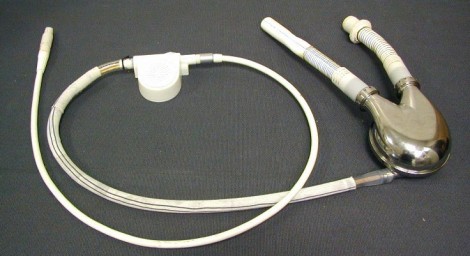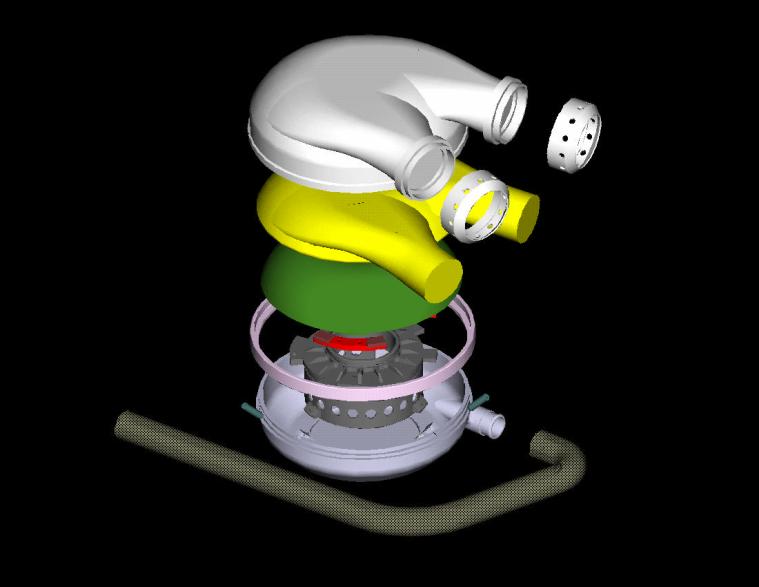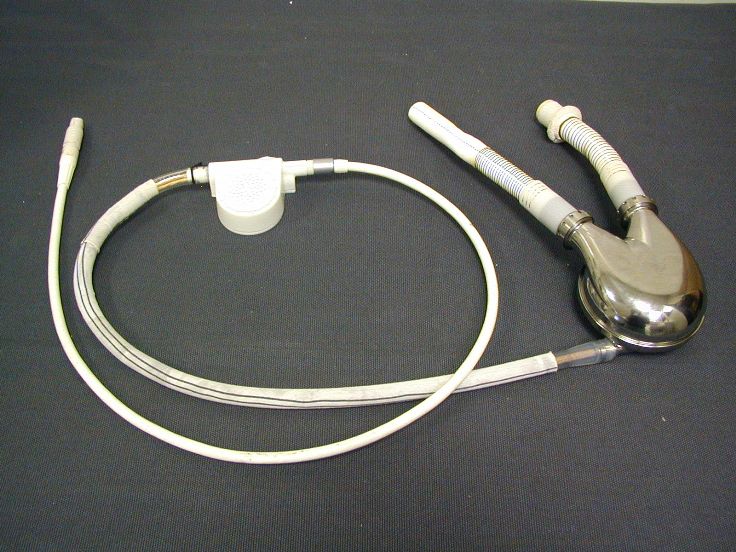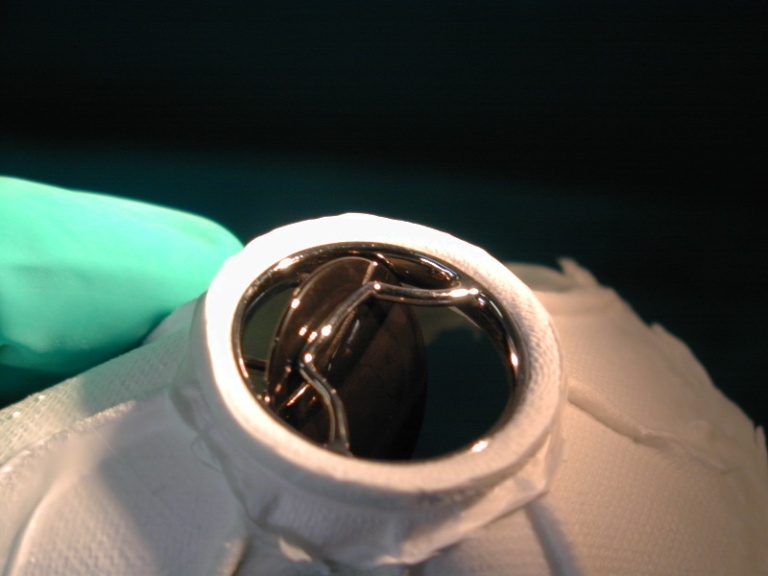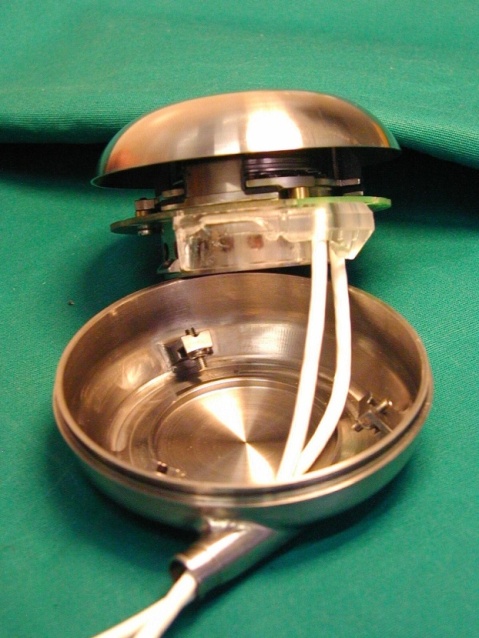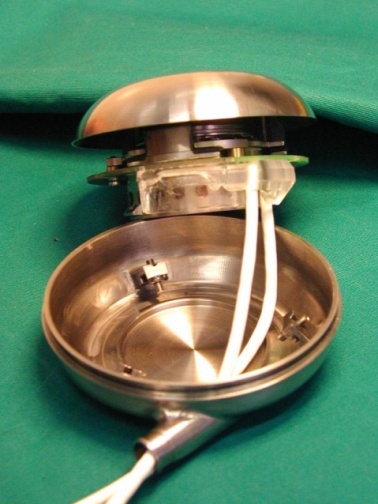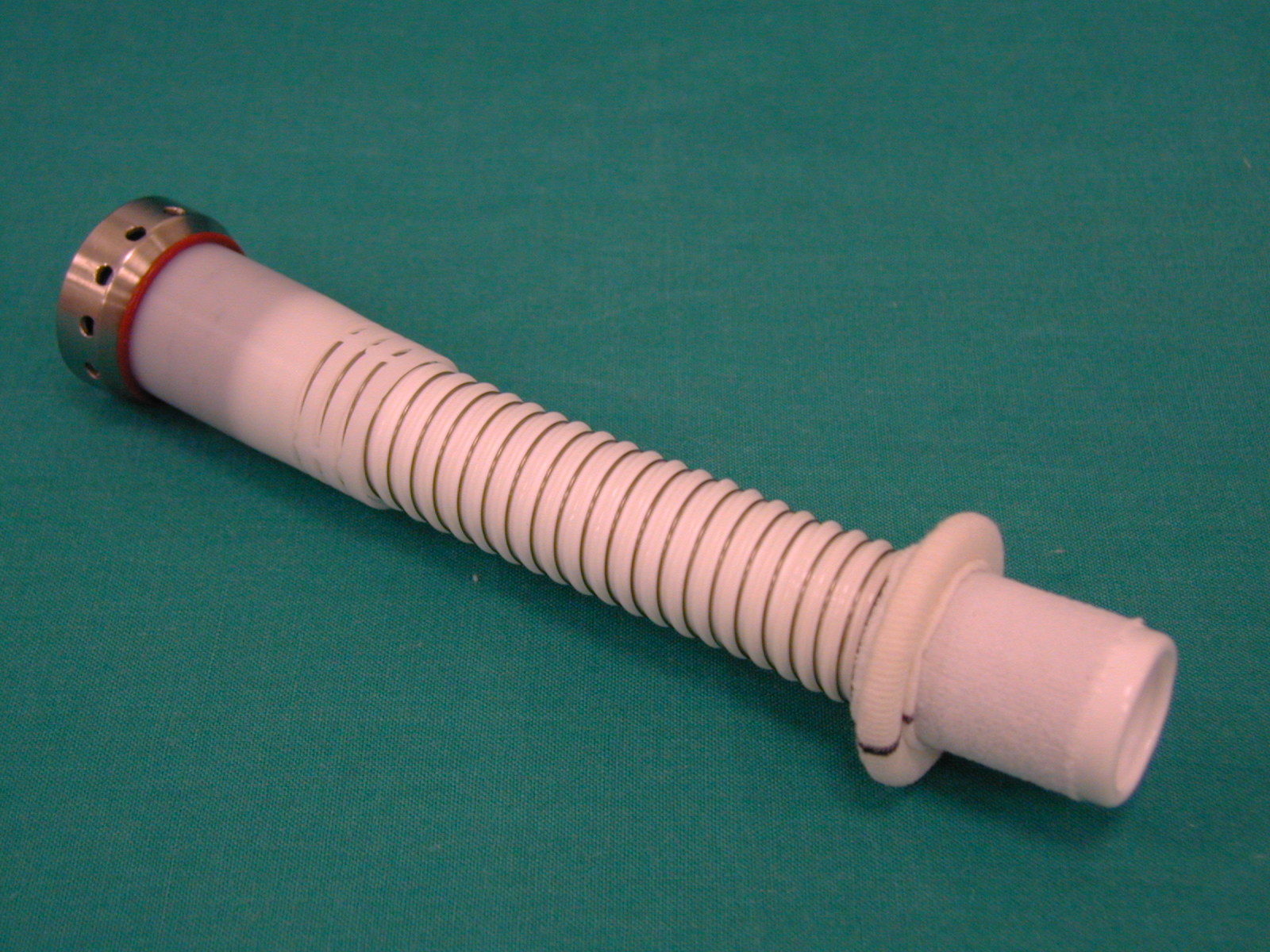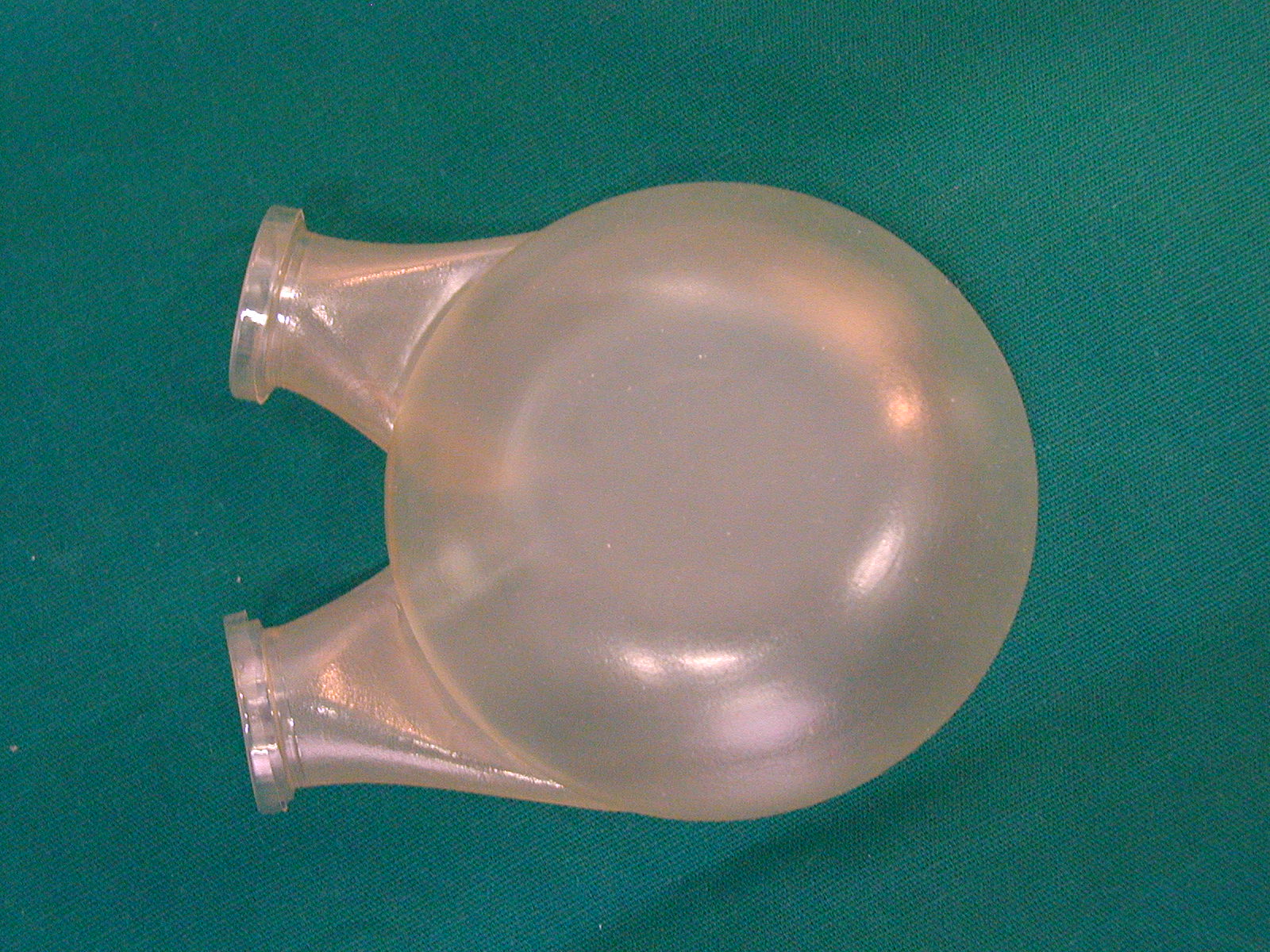VAD sta per Dispositivo di Assistenza Ventricolare e consiste in una pompa impiantabile alimentata con batterie ricaricabili che provvede ad imprimere al sangue la pressione ed il flusso fisilogici in un paziente il cui cuore, affetto ad esempio da miocardiopatia dilatativa, non è più in grado di pompare adeguate quantità di sangue. In questo sistema di assistenza la pompa si riempie a pressione bassissima ricevendo il sangue dal ventricolo sinistro attraverso una cannula ed un istante dopo eietta lo stesso volume in aorta alla pressione di 150-160 mmHg. La pompa in questione è di tipo volumetrico pulsatile e contiene una sacca in poliuretano morbido su cui preme un piattello collegato ad una vite senzafine movimentata da una bussola a ricircolo di sfere messa in rotazione da un motore elettrico dalle elevate prestazioni elettromeccaniche.Sia la sacca che il motore sono contenuti in un guscio di titanio finissimo, ma leggero in grado di isolare ermeticamente il motore dall’ambiente corporeo interno.L’alimentazione elettrica al motore viene portata da una linea elettrica anch’essa isolata dall’ambiente umido dell’interno del corpo. Essa passa attraverso la cute ed è previsto che sia rimossa al termine della terapia. Già perchè è di terapia che si parla quando la tcnologia permette di scaricare il ventricolo malato e sofferente della maggiorparte dello sforzo di pompaggio perchè possa riprendersi e riacquistare funzionalità. Questo dispositivo medico è arrivato nel 2008 ad un passo dall’ottenere la marcatura CE come dispositivo medicale attivo. L’improvviso venir meno di una piccola quota finale di finanziamento ha provocato l’interruzione del progetto ed il fallimento della società che lo aveva portato avanti sino a quel punto.
DIAPOSITIVE
click on the picture hereunder
click on the picture above
http://www.umbrausa.com
DICHIARAZIONI STAMPA
ANCHE UN PAZIENTE FRANCESE RICEVE L’IMPIANTO DI UNA POMPA CARDIACA ITALIANA.
Pomezia, Roma, 10 Marzo 2007. NewCorTec, l’azienda italiana che fabbrica la pompa cardiaca BestBeat, annuncia di aver avviato anche in Francia lo studio clinico del suo dispositivo di assistenza ventricolare (VAD) che è noto con il nome di BestBeat. Il dispositivo è stato impiantato nel torace di un paziente francese nel prestigioso Istituto del Cuore all’ospedale della Pitiè Salpetrière di Parigi.
L’operazione è stata eseguita il 9 Maggio dal Prof.Alain Pavie ed il suo team chirurgico. Il paziente, di 55 anni, soffriva di un grave disordine cardiaco e l’operazone è stata un successo. Il suo cuore ora funziona meglio grazie a questo dispositivo fatto in Italia.
PER L’ITALIA L’ANNUNCIO DELL’AUTORIZZAZIONE MINISTERIALE DOVREBBE ESSERE FATTO A BREVE.
I previsti studi clinici del VAD, della durata di circa un anno, coinvolgono un ospedale tedesco, due cliniche francesi e quattro centri italiani (Ospedali Riuniti di Bergamo, Centro Cardiochirurgico del CNR di Massa, Ospedale Niguarda di Milano, e il Policlinico San Matteo di Pavia). Tuttavia, la fase di sperimentazione nei quattro centri italiani è ancora in attesa di autorizzazione da parte del Ministero della Salute.
Le prove sugli esseri umanisono partiti dopo molti anni di studio e di ricerca che hanno coinvolto diverse cliniche, chirurghi e ricercatori italiani, che non ha risparmiato sforzi per sviluppare e perfezionare il VAD. In primo luogo, il professor Luigi Donato, direttore dell’Istituto di Fisiologia Clinica del CNR di Pisa, e “padre” del dispositivo, così come il professor Paolo Ferrazzi, che ha guidato la squadra per gli studi pre-clinici, e il dottor Stefano Rinaldi, che ha guidato il gruppo di ricerca che ha sviluppato il dispositivo.
Dopo la fase di studio clinico l’azienda intende ottenere il Marchio CE per la primavera del 2008.
In tutto il mondo ci sono 100.000 pazienti all’anno con disturbi cardiaci gravi che potrebbero essere fatali a breve termine. A fronte a questa situazione, ci sono solo 3-4.000 donatori all’anno, con una lista d’attesa che è ben oltre quel numero. In questo contesto, un dispositivo di assistenza ventricolare è l’opzione più realistica come “ponte al trapianto”. Tuttavia, molti pazienti non sono in grado di sottoporsi a chirurgia dei trapianti, e la “terapia di assistenza permanente” può fornire una risposta efficace a un bisogno che è in gran parte irrisolto oggi.
Il dispositivo fatto in Italia contiene elementi innovativi che lo rendono adatto non solo come “ponte al trapianto” e “terapia permanente”, ma anche come strumento terapeutico utile per recuperare funzioni cardiache, quando le condizioni del paziente lo rendono possibile. In questo senso, il VAD Best Beat può essere visto anche come un “ponte di recupero” per i cuori malfunzionanti.
VAD is the acronym of Ventricular Assist Device and consists of an implantable pulsatile pump powered with rechargeable batteries that provides to impress to the blood physiological pressure and the flow in a patient whose heart , affected for example by dilated cardiomyopathy , is no longer able to pump adequate amounts of blood. In this assistance system the pump fills up with blood at very low pressure coming from the left ventricle through a flexible pipe and a moment later ejects the same volume into the aorta at a pressure of 150-160 mmHg. The pump in question is of pulsatile, volumetric type and contains a pouch in soft polyurethane on which presses a plate connected to an endless screw where the threads are filled with ball bearings that recirculate through the gear and rack, put in rotation by an electric motor with high electromechanical performance Both thebag that the motor are contained in a shell of titanium, lightweight but able to hermetically insulate the motor from the internal human body. Power supply is carried to the motor by a power line which is also isulated from the humid internal body. The power line passes through the skin and is expected to be removed together with the pump at the end of therapy. Yes, because this therapy is intended successfully when the employed technology allows to download ventricle sick and suffering of the majority of the effort of pumping so that it can recover and regain functionality. This medical device came in 2008 to a step from obtaining the CE mark as an active medical device . The sudden disappearance of a small portion of the final funding has resulted in the interruption of the project and the failure of the company that had brought it up to that point forward .
DIAPOSITIVE
click on the picture hereunder
click on the picture above
http://www.umbrausa.com
PRESS RELEASE
FRENCH PATIENT ALSO RECEIVES IMPLANT OF ITALIAN-MADE HEART PUMP.
Pomezia, Rome, 10 March 2007. NewCorTec, the Italian firm that produces the heart pump BestBeat, announces that clinical trials of its Ventricular Assistance Device (VAD) known as BestBeat have also started in France. The device was implanted in the thorax of a French patient at the prestigious Institut du Coeur of the Pitiè Salpetrière hospital in Paris.
The operation was carried out on May 9 by Prof Alain Pavie and his cardio-surgery team. The patient, aged 55, suffers from a serious heart disorder, and the operation was successful. His heart now functions better thanks to this Italian-made device.
FOR ITALY, MINISTERIAL AUTHORISATION SHOULD BE ANNOUNCED SHORTLY.
Clinical trials of the VAD, lasting about a year, involve a German hospital, two French clinics and four Italian centres (Ospedali Riuniti in Bergamo, Centro Cardiochirurgico del CNR in Massa, Ospedale Niguarda in Milan, and the Policlinico San Matteo in Pavia). However, the trial phase in the four Italian centres is still awaiting authorisation from the Ministry of Health.
Trials on human beings began after many years of study and research involving several clinics, surgeons and Italian researchers, who spared no efforts to develop and perfect the VAD. First and foremost, Professor Luigi Donato, Director of the CNR Institute of Clinical Physiology in Pisa, and “father” of the device, as well as Professor Paolo Ferrazzi, who headed the team for pre-clinical trials, and Dr Stefano Rinaldi who led the research team which developed the device.
After the phase of human trials, the company expects to obtain European certification (CE marking) for the device by spring 2008.
Worldwide there are 100,000 patients a year with serious heart disorders which could be fatal in the short term. Faced with this situation, there are only 3-4,000 donors a year, with a waiting list that is well over that number. Against this background, a ventricular assist device is the most realistic option as a “bridging transplant”. However, many patients are unable to undergo transplant surgery, and “permanent assistance therapy” can provide an effective response to a need which is largely unresolved today.
The Italian-made device contains innovative elements which make it suitable not only as a “bridging transplant” and “permanent therapy”, but also as a valuable therapeutic tool for recovering cardiac functions, whenever the patient’s condition makes this possible. In this sense, the VAD can also be viewed as a “recovery bridge” for malfunctioning hearts.
